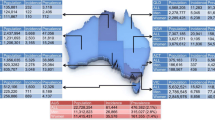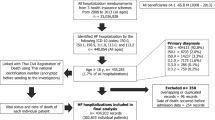Abstract
Aims
Heart failure (HF) continues to be a leading cause of morbidity and mortality in industrialized countries. Data on the epidemiology of HF are largely lacking for Germany. The aims of this study were to estimate the incidence and prevalence of HF in Germany, to estimate 1-year all-cause mortality in patients who received their first diagnosis of HF in hospital and to assess related risk factors.
Methods
The study was based on data for the years 2004–2006 from three German statutory health insurance providers, comprising data of more than six million people. The study sample was not restricted to a specific age group. The incidence rate of HF in 2006 was assessed in patients who did not have a diagnosis of HF or had not received medications for HF in the previous 2 years. One-year all-cause mortality in patients who received their first diagnosis of HF in hospital was analysed using Kaplan–Meier method and Cox proportional hazard model. Case identification was based on confirmed outpatient diagnoses, main and secondary hospital discharge diagnoses as well as medications for HF.
Results
The age- and sex-standardized incidence rate of HF was 2.7 per 1000 person years. Age- and sex-standardized prevalence of HF was 1.7 % in 2004, 1.9 % in 2005 and 1.7 % in 2006. The 1-year all-cause mortality was 23 % among patients who received their first HF diagnosis during a hospitalization in 2006.
Conclusion
Our study revealed an incidence and prevalence of HF in Germany which were largely comparable to those from other countries. Due to the poor prognosis of HF, high readmission rates and an aging society, HF remains highly relevant in the context of health care planning.



Similar content being viewed by others
References
McMurray JJ, Pfeffer MA (2005) Heart failure. Lancet 365(9474):1877–1889
Bui AL, Horwich TB, Fonarow GC (2011) Epidemiology and risk profile of heart failure. Nat Rev Cardiol 8(1):30–41
Zarrinkoub R, Wettermark B, Wandell P, Mejhert M, Szulkin R, Ljunggren G, Kahan T (2013) The epidemiology of heart failure, based on data for 2.1 million inhabitants in Sweden. Eur J Heart Fail 15(9):995–1002
Gerste B, Günster C, Heller G, Hilfer S (2007) Sektorenübergreifende Leistungsanalysen. Inanspruchnahme von Gesundheitsleistungen durch Patienten mit koronarer Herzkrankheit und Herzinsuffizienz, Bonn
Hoffmann F, Icks A (2012) Structural differences between health insurance funds and their impact on health services research: results from the Bertelsmann Health-Care Monitor. Gesundheitswesen 74(5):291–297
Statistisches Bundesamt (2011) Gesundheit: Diagnosedaten der Patienten und Patientinnen in Krankenhäusern, Wiesbaden
Statistisches Bundesamt (2010) Gesundheit: Krankheitskosten, 2002, 2004, 2006 and 2008, Wiesbaden
Cleland JG, Gemmell I, Khand A, Boddy A (1999) Is the prognosis of heart failure improving? Eur J Heart Fail 1(3):229–241
Blackledge HM, Tomlinson J, Squire IB (2003) Prognosis for patients newly admitted to hospital with heart failure: survival trends in 12 220 index admissions in Leicestershire 1993–2001. Heart 89(6):615–620
Jong P, Vowinckel E, Liu PP, Gong Y, Tu JV (2002) Prognosis and determinants of survival in patients newly hospitalized for heart failure: a population-based study. Arch Intern Med 162(15):1689–1694
MacIntyre K, Capewell S, Stewart S, Chalmers JW, Boyd J, Finlayson A, Redpath A, Pell JP, McMurray JJ (2000) Evidence of improving prognosis in heart failure: trends in case fatality in 66 547 patients hospitalized between 1986 and 1995. Circulation 102(10):1126–1131
Garbe E, Suling M, Kloss S, Lindemann C, Schmid U (2011) Linkage of mother-baby pairs in the German pharmacoepidemiological research database. Pharmacoepidemiol Drug Saf 20(3):258–264
Pigeot I, Ahrens W (2008) Establishment of a pharmacoepidemiological database in Germany: methodological potential, scientific value and practical limitations. Pharmacoepidemiol Drug Saf 17(3):215–223
Deutsches Institut für Medizinische Dokumentation un Information (2011) Internationale Statistische Klassifikation der Krankheiten und verwandter Gesundheitsprobleme: 10. Revision: Version 2008. https://www.dimdi.de/static/de/klassi/icd-10-gm/kodesuche/onlinefassungen/htmlgm2008/index.htm. Accessed 26 Jan 2014
Daly LE (1998) Confidence limits made easy: interval estimation using a substitution method. Am J Epidemiol 147(8):783–790
Newcombe R, Altman D (2000) Proportions and their differences. In: Altman D, Machin D, Bryant T, Gardner M (eds) Statistics with confidence. British Medical Journal Books, Bristol, pp 45–56
International Agency for Research on Cancer (1976) Cancer incidence in five continents. Volume IIV, Lyon
Fay MP, Feuer EJ (1997) Confidence intervals for directly standardized rates: a method based on the gamma distribution. Stat Med 16(7):791–801
Bleumink GS, Knetsch AM, Sturkenboom MC, Straus SM, Hofman A, Deckers JW, Witteman JC, Stricker BH (2004) Quantifying the heart failure epidemic: prevalence, incidence rate, lifetime risk and prognosis of heart failure The Rotterdam Study. Eur Heart J 25(18):1614–1619
Cowie MR, Wood DA, Coats AJ, Thompson SG, Poole-Wilson PA, Suresh V, Sutton GC (1999) Incidence and aetiology of heart failure; a population-based study. Eur Heart J 20(6):421–428
Regitz-Zagrosek V, Oertelt-Prigione S, Seeland U, Hetzer R (2010) Sex and gender differences in myocardial hypertrophy and heart failure. Circ J 74(7):1265–1273
Leong KT, Goh PP, Chang BC, Lingamanaicker J (2007) Heart failure cohort in Singapore with defined criteria: clinical characteristics and prognosis in a multi-ethnic hospital-based cohort in Singapore. Singap Med J 48(5):408–414
Cleland JG, McDonagh T, Rigby AS, Yassin A, Whittaker T, Dargie HJ, National Heart Failure Audit Team for E, Wales (2011) The national heart failure audit for England and Wales 2008–2009. Heart 97(11):876–886
Khand AU, Shaw M, Gemmel I, Cleland JG (2005) Do discharge codes underestimate hospitalisation due to heart failure? Validation study of hospital discharge coding for heart failure. Eur J Heart Fail 7(5):792–797
Schink T, Garbe E (2010) Assessment of the representativity of in-patient hospital diagnoses in the German Pharmacoepidemiological Research Database. Pharmacoepidemiol Drug Saf 19:S178–S179
Schink T, Garbe E (2010) Representativity of dispensations of non-steroidal anti-inflammatory drugs (NSAIDs) in the German Pharmacoepidemiological Research Database. Pharmacoepidemiol Drug Saf 19:S294
Ohlmeier C, Schmedt N, Hillebrand K, Langner I, Mikolajczyk R, Garbe E (2013) Validation of mortality related information in the German Pharmacoepidemiological Research Database (GePaRD). Pharmacoepidemiol Drug Saf 22(S1):306
Acknowledgments
The authors are grateful to all statutory health insurances that provided data for this study, namely the AOK Bremen/Bremerhaven, the Techniker Krankenkasse (TK), and the hkk. This work was supported by the Robert Koch-Institute, [Grant Number 1362/1-922].
Conflict of interest
The authors had complete autonomy for the process of establishing the protocol, carrying out the analyses and interpreting the results. This also includes the full right to publish the results without limitation. Rafael Mikolajczyk reports grants from Bayer Pharma, grants from Sanofi Pasteur, outside the submitted work. Wilhelm Haverkamp reports speaker’s bureau activities for Bayer HealthCare, Boehringer Ingelheim, Daiichi Sankyo and Berlin Chemie.
Ethics
Use of the data for research purposes needs to be approved by the contributing SHIs and by their governing local or federal authorities. In accordance with the Code of Social Law (SGB X), informed consent of the insurants was not required. Since the study was based on routinely collected pseudonymized data and persons were not contacted, a vote of the ethics committee was not needed.
Author information
Authors and Affiliations
Corresponding author
Electronic supplementary material
Below is the link to the electronic supplementary material.
Rights and permissions
About this article
Cite this article
Ohlmeier, C., Mikolajczyk, R., Frick, J. et al. Incidence, prevalence and 1-year all-cause mortality of heart failure in Germany: a study based on electronic healthcare data of more than six million persons. Clin Res Cardiol 104, 688–696 (2015). https://doi.org/10.1007/s00392-015-0841-4
Received:
Accepted:
Published:
Issue Date:
DOI: https://doi.org/10.1007/s00392-015-0841-4




